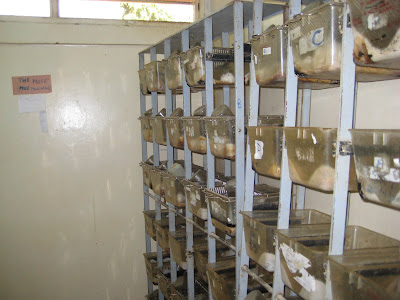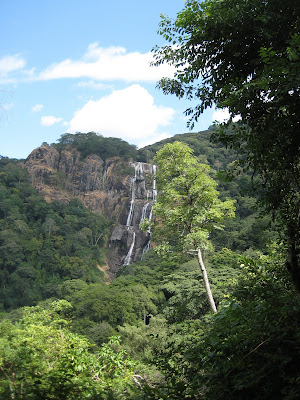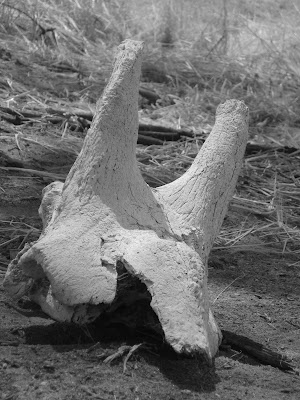We went out into a different area of the park today to survey fire management plots for signs of animal presence. Meing'Ataki and the other park staff have been conducting surveys on four different fire management regimes: burning early in the dry season, burning late in the dry season, burning both early and late in the season, and no burning. They've been monitoring the vegetation, and we were there today to look at the animal distribution in the plots.
 Lunch at the fire site
Lunch at the fire siteWe were looking for elephant, impala, giraffe, and zebra poop in each plot, to determine who was using each area. We counted up piles and compared the different plots, and gave the data to Mzee Mbano so that he could do some statistical analysis, and compare it to the data that the Envirovet group collected last year at this time.
 Meing'Ataki and Harrison, our Tanzanian experts
Meing'Ataki and Harrison, our Tanzanian expertsInitially, it looked like the elephants used the unburned areas more, while the impala used the early and late burns--in my mind, this difference might also be due to the fact that in the unburned area the vegetation was much thicker, and we may have missed the small impala poop that we had no trouble seeing in the more sparsely vegetated burned areas. It was cool to be able to get out of the cars and walk around in the park, and the weather was really nice. Quartz is really common in Ruaha, and I found some really pretty pink, orange and white pieces.
 Liz and Deanna, our course leaders
Liz and Deanna, our course leadersThe drive out to the fire plots was about two hours long, and we took extra time on the way back to look for more animals by the river. We saw more lions today, a male and a female sleeping under trees, and lots of the usual twiga, swala, and tembo. We also spotted some Roan antelope in the distance, and a couple of dik-diks. I saw a squirrel climbing up a tree, which I didn't think was weird at first, but then realized that it was probably the first squirrel I'd seen since leaving Ithaca for the summer. We also stopped under a tree full of vervet monkeys to watch them eat the elephant sausage, the fruit of the tree that the elephants really like, and that's shaped like sausage.
 Giraffe along the drive back to headquarters
Giraffe along the drive back to headquartersBecause it was our last night in Ruaha, the staff had a special barbeque for us, complete with bia (beer), bbq mbuzi, and homemade cake.
 The banda I shared with Valentina at Ruaha
The banda I shared with Valentina at Ruaha Ruaha staff barbecuing mbuzi for our last night
Ruaha staff barbecuing mbuzi for our last nightAround sunset, a big bull elephant came up out of the riverbed that runs behind the bandas we were staying in, and walked lazily through our banda site, grazing on some of the trees that shaded the fire area. Though I'd heard the lions and some hippo noises the past few days, this was the first actual animal I'd seen walking through our campsite, so that was pretty cool.
 Group at the BBQ on the last night in Ruaha
Group at the BBQ on the last night in RuahaAfter the barbeque, Meing'Ataki invited us all up to a dance party that he organized for us and the Ruaha staff and residents. When we first got there, all the lights were on, the music was blasting American pop from the 1990s, and no one was dancing. Finally some people started to trickle onto the dance floor, and when the DJ switched to Tanzanian pop, everyone was much more comfortable. Deanna kicked off the party with Dr. Alex, both of them breakin it down in the middle of our little dancing circle. By the time the speakers caught on fire and the DJ had to move out of his booth to a new spot with different speakers on the floor, we Envirovet mwuzungu had started to mingle with the Tanzanians on the dance floor. Lots of us girls got pretty good at finding the happy medium between dancing with the Tanzanian men for a little while, and then running away from them when they started getting too "grabby," as Joanna put it. The drivers of our vans and Rovers were also at the party, so it was fun to include them and dance with them too.
 Ruaha dance party!
Ruaha dance party!The end of the night came quickly around midnight when Harrison and some of the other Evets started a waterfight, and everyone ended up soaked and cold. Back at the campsite, still too excited to get to sleep, Mike, D, and I sat by the campfire watching for animals. We saw a couple black-backed jackels and a mongoose, and made friends with the guard, who explained how to use his AK-47 rifle and let us all hold it. Now that was a Facebook photo!
 I'm holding an AK-47
I'm holding an AK-47 Me and Helen in the Dar Airport, feeling homeless and sad, and working on our crafting skills so we can learn how to live on the streets
Me and Helen in the Dar Airport, feeling homeless and sad, and working on our crafting skills so we can learn how to live on the streets




















































